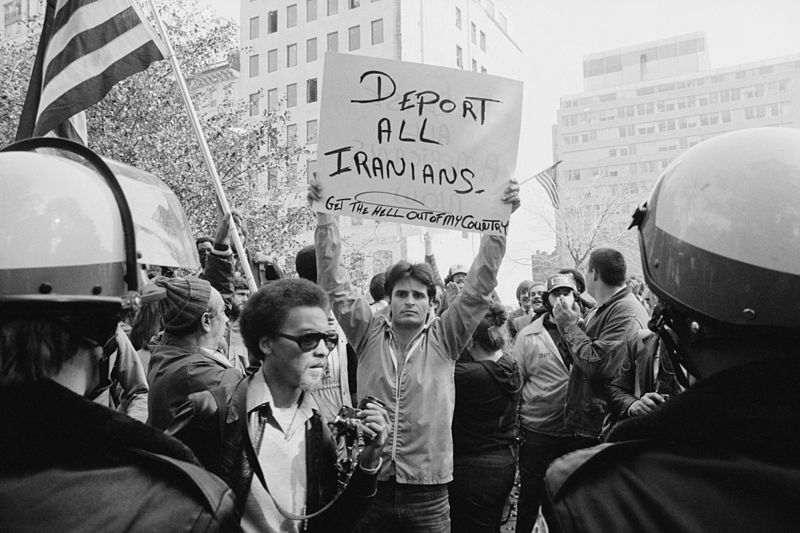Putting Evil in Context
In the 1970s, the terror group known as the Mujahedeen e-Khalq (People’s Mujahedeen of Iran), or MEK was responsible for political assassinations, bombings, and attempted plane hijackings. In the 1990s, the MEK cooperated with Saddam Hussein in his brutal crackdown of Iraqi Shia and Kurds. But the latest news out of Washington suggests a totally different understanding of the MEK. Last week, the U.S. State Department removed this very group from its weighty list of foreign terrorist organizations, a change overseen by Hillary Clinton herself.
On the face of it, the United States just pardoned a terror group with a record of terrorist activity. Worse, this group is Iranian, suggesting that the U.S. is dealing with this obviously threatening country in less than appropriately stringent ways. But within the story of the MEK lies the greater story of the ways in which the ideology and activity of a given entity can change, sometimes for worse and sometimes for better. Within it lies a message for those warmongering for an American or Israeli strike on Tehran, and a message for those today who see history as static and the future as fixed.
The MEK was founded in 1963 in opposition to the Western-backed Shah, and supported the Islamist overthrow in 1979 (a widely supported and somewhat reasonable endeavor at the time). Things started to turn ugly very quickly, and the MEK soon after found itself supporting the takeover of the U.S. embassy. But after this, illustrating a new purity of heart but perverse set of tactics, the MEK began plotting against the same ruling Islamist clerics they helped bring to power, killing both the president and prime minister. They began fighting for the right thing in the wrong way.
Relatively noble and understandable intentions soon gave way to the makings of a borderless destabilizing force as the group took up camp in Iraq in 1986 following their exile from Iran. MEK would soon take part in Iraq’s war against Iran, as could’ve been expected given their ideological alignment, and its members were used to tragic effect in suicide attack waves against the Revolutionary Guard. From Iraq, the group continued to plot Iranian assassination attempts into the early 2000s.
At the same time as all this violence, though, the MEK maintained standards and values that are considered unheard of this kind of group in this part of the world. Members of the MEK are ardent feminists: The group is led by a joint husband and wife team, and the MEK is the only army in the world with a commander corps composed largely of women. And, for all the terror they have implemented in their past, in 2001 the group renounced terrorism, and has sought ever since to join the mainstream Iranian opposition movement. What does all this tell us about the MEK?
On the one hand, Iranian commentators have noted that they are seen in Iran as a backwards cult and so should have no place in the opposition movement for a more democratic government. But on the other, the MEK has effectively obeyed American instructions to evacuate Camp Ashraf this summer, doing so without violence. Former directors of the CIA and FBI have argued MEK’s case, and politicians as high profile as Newt Gingrich have spoken often in support of the group. The MEK, if still responsible for the terror acts they committed in the past, seems to have altered its ways in search of a new position from which to challenge the current Iranian regime’s undemocratic affairs. The group’s recent turnaround, and removal from the terror list, does not and cannot atone for its violent past. But it makes a simple one-line classification of the MEK impossible.
The moral of the MEK story does not apply to it alone. It might come as a surprise to many that such a simple classification is impossible, too, for MEK’s parent country: the Islamic Republic of Iran. Despite the fact that politics in Iran are a famously shifting landscape, and have endured many turnarounds in not as many years, pundits and policymakers abroad have looked and continue to look at Iran’s policies in naively singular lights: Many viewed the reformist successes in 1990s to be the beginning of a long-lasting democratic period, while many today see the current conservative clerical rule as a permanent evil. And those fond of citing Ahmadinejad’s disgustingly anti-Israel rhetoric (most recently this very week at the UN) fail to remember that his predecessor Khatami rejected anti-Semitism and opened the door for Jewish scholars to participate in his Dialogue of Civilizations.
Without a doubt, this current Iranian regime has hostile intentions – though how hostile can be debated – and must be treated accordingly. But the Iranian government is not the Iranian people, and the Iranian people of today are not the Iranian people of ten years ago. Too often, many of us in the West think of our current enemies in the same monolithic way that we so often accuse them of viewing us. The MEK teaches us that the search for simple characterizations is no more than a very common fool’s errand. It would be wise of us all to take heed.

